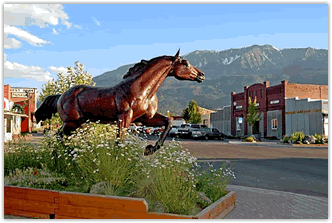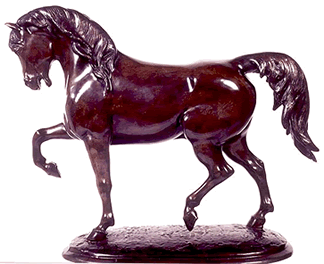The Story behind Venice's bronze Horses
|
The handsome horses of the title of this erudite work are bronze statues for centuries associated as spiritual symbols of Venetian identity. For many years they commanded a position in St. Mark's Square, the equal of the now more famous Lion, and as intimately intertwined with the city's protean identity as that piece. A newly victorious Napoleon took the horses as part of his sack of Venice and other Italian cities for a triumphal march through Paris ('Rome is no longer in Rome, it is all in Paris'), and it is a mark of how keenly their loss was felt that the Venetian artist Antonio Canova should tax Napoleon repeatedly for their return above all other treasures to the city.
One of the many interesting facts we learn here is that just like the Lion (which Napoleon also removed, setting it in Paris with its tail remodelled to hang between its legs), the horses were not originally Venetian, but actually plunder from Constantinople after the Fourth Crusade, a seedy adventure masterminded by Venice's Doge, Enrico Dandolo, who as a young diplomat had lost an eye during a scuffle in Byzantium, thereafter aching to avenge himself on Venice's erstwhile colonial master. That Mr Freeman can demonstrate to the lay reader the symbolic sadism of the removal of what were four statues amongst many great works of art indicates the detail and force of a book that nimbly presents the general reader with a vast tapestry of knowledge: from the technology of ancient bronze casting, through political and military history that includes pre-Christian Rome and Greece as well as Renaissance Europe, and on to the aesthetic debates of the eighteenth and nineteenth centuries, Charles Freeman wears his learning very lightly indeed, making this a useful primer for the generally interested. The author lights and fans the narrative spark with the mystery of the horses' provenance (something unlikely ever to be settled comprehensively), but having laboured to interest us with this, he then takes off on the necessary mission of tackling the many ancillary subjects that we must have some understanding of in order to appreciate the significance of the horses. Therein lies one's major concern with the book; one must ask if the horses' shoulders may prove a little too slight to bear the weight of the insights being loaded on to them. Mr Freeman's triumph here is less to do with offering an educated theory about the origins of the horses. Rather he demonstrates how Art History is not some trivial study of ornament, but an exciting nexus of Art and Politics. Those in power have always sought to influence the images and associations attached to themselves and their reputations. (Napoleon is but one example; Berlusconi's grip on the Italian media is a more immediate one.) This book may not be to all tastes, but a curious reader will find many intellectual strands twisted together here, most likely in unusual patterns. It is Charles Freeman's success that by the end one hoped that his calls for the horses to be brought out from their protective chamber to watch over St. Mark's Square again will be heeded. |
  |